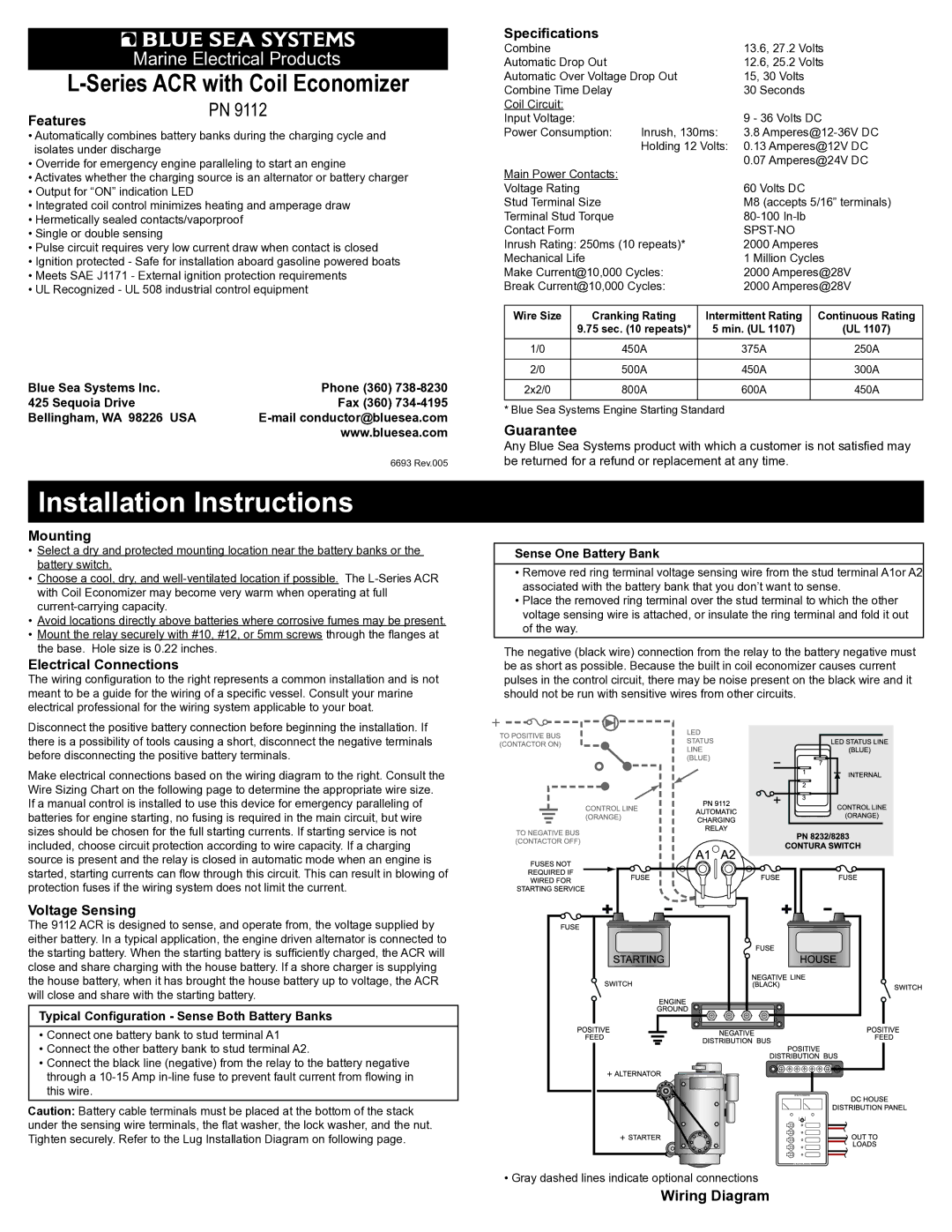
Marine Electrical Products
L-Series ACR with Coil Economizer
Features | PN 9112 |
|
•Automatically combines battery banks during the charging cycle and isolates under discharge
•Override for emergency engine paralleling to start an engine
•Activates whether the charging source is an alternator or battery charger
•Output for “ON” indication LED
•Integrated coil control minimizes heating and amperage draw
•Hermetically sealed contacts/vaporproof
•Single or double sensing
•Pulse circuit requires very low current draw when contact is closed
•Ignition protected - Safe for installation aboard gasoline powered boats
•Meets SAE J1171 - External ignition protection requirements
•UL Recognized - UL 508 industrial control equipment
Blue Sea Systems Inc. | Phone (360) | |
425 Sequoia Drive | Fax (360) | |
Bellingham, WA 98226 USA | ||
| www.bluesea.com | |
| 6693 Rev.005 | |
Installation Instructions
Mounting
•Select a dry and protected mounting location near the battery banks or the battery switch.
•Choose a cool, dry, and
•Avoid locations directly above batteries where corrosive fumes may be present.
•Mount the relay securely with #10, #12, or 5mm screws through the flanges at the base. Hole size is 0.22 inches.
Electrical Connections
The wiring configuration to the right represents a common installation and is not meant to be a guide for the wiring of a specific vessel. Consult your marine electrical professional for the wiring system applicable to your boat.
Disconnect the positive battery connection before beginning the installation. If there is a possibility of tools causing a short, disconnect the negative terminals before disconnecting the positive battery terminals.
Make electrical connections based on the wiring diagram to the right. Consult the Wire Sizing Chart on the following page to determine the appropriate wire size. If a manual control is installed to use this device for emergency paralleling of batteries for engine starting, no fusing is required in the main circuit, but wire sizes should be chosen for the full starting currents. If starting service is not included, choose circuit protection according to wire capacity. If a charging source is present and the relay is closed in automatic mode when an engine is started, starting currents can flow through this circuit. This can result in blowing of protection fuses if the wiring system does not limit the current.
Voltage Sensing
The 9112 ACR is designed to sense, and operate from, the voltage supplied by either battery. In a typical application, the engine driven alternator is connected to the starting battery. When the starting battery is sufficiently charged, the ACR will close and share charging with the house battery. If a shore charger is supplying the house battery, when it has brought the house battery up to voltage, the ACR will close and share with the starting battery.
Typical Configuration - Sense Both Battery Banks
•Connect one battery bank to stud terminal A1
•Connect the other battery bank to stud terminal A2.
•Connect the black line (negative) from the relay to the battery negative through a
Caution: Battery cable terminals must be placed at the bottom of the stack under the sensing wire terminals, the flat washer, the lock washer, and the nut. Tighten securely. Refer to the Lug Installation Diagram on following page.
Specifications
Combine |
|
|
| 13.6, 27.2 Volts | ||
Automatic Drop Out |
|
| 12.6, 25.2 Volts | |||
Automatic Over Voltage Drop Out |
| 15, 30 Volts |
| |||
Combine Time Delay |
|
| 30 Seconds |
| ||
Coil Circuit: |
|
|
|
|
| |
Input Voltage: |
|
|
| 9 - 36 Volts DC | ||
Power Consumption: | Inrush, 130ms: | 3.8 | ||||
|
|
| Holding 12 Volts: | 0.13 Amperes@12V DC | ||
Main Power Contacts: |
|
| 0.07 Amperes@24V DC | |||
|
|
|
| |||
Voltage Rating |
|
|
| 60 Volts DC |
| |
Stud Terminal Size |
|
| M8 (accepts 5/16” terminals) | |||
Terminal Stud Torque |
|
|
| |||
Contact Form |
|
|
|
|
| |
Inrush Rating: 250ms (10 repeats)* |
| 2000 Amperes | ||||
Mechanical Life |
|
|
| 1 Million Cycles | ||
Make Current@10,000 Cycles: |
| 2000 Amperes@28V | ||||
Break Current@10,000 Cycles: |
| 2000 Amperes@28V | ||||
|
|
|
|
| ||
Wire Size |
| Cranking Rating | Intermittent Rating | Continuous Rating | ||
| 9.75 sec. (10 repeats)* | 5 min. (UL 1107) | (UL 1107) | |||
1/0 |
|
| 450A |
| 375A | 250A |
|
|
|
|
|
|
|
2/0 |
|
| 500A |
| 450A | 300A |
|
|
|
|
|
|
|
2x2/0 |
|
| 800A |
| 600A | 450A |
|
|
|
|
|
|
|
* Blue Sea Systems Engine Starting Standard
Guarantee
Any Blue Sea Systems product with which a customer is not satisfied may be returned for a refund or replacement at any time.
Sense One Battery Bank
•Remove red ring terminal voltage sensing wire from the stud terminal A1or A2 associated with the battery bank that you don’t want to sense.
•Place the removed ring terminal over the stud terminal to which the other voltage sensing wire is attached, or insulate the ring terminal and fold it out of the way.
The negative (black wire) connection from the relay to the battery negative must be as short as possible. Because the built in coil economizer causes current pulses in the control circuit, there may be noise present on the black wire and it should not be run with sensitive wires from other circuits.
• Gray dashed lines indicate optional connections
Wiring Diagram
